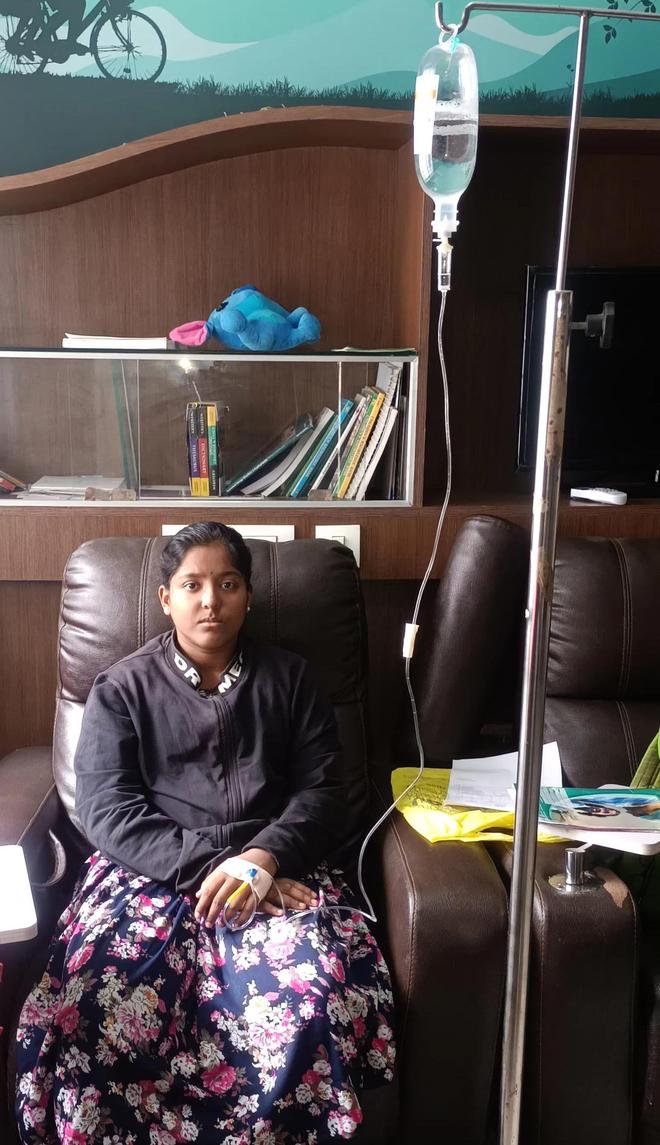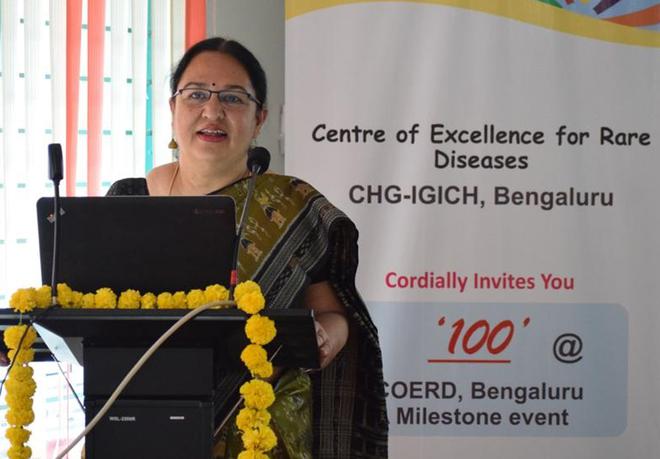Vinutha M. is a 23-year-old pharmacy student in the nondescript town of Nelamangala, about 30 kilometres northwest of Bengaluru. The life of this frail woman is a story of indomitable courage, resounding resilience, and unwavering determination not to be cowed down by a rare genetic disease that modern medicine has yet to find a cure for.
When she was nine, Vinutha’s parents noticed that some of the worrying symptoms she always had — poor appetite and an intolerance for solid food — were worsening. “All through her childhood, we fed her just milk. She had a skinny body but a huge abdomen. In high school, she was embarrassed to attend class with a huge abdomen. The only consolation was that she had no neurological impairment,” recalls her mother, Kalpana Murugesh.

They visited multiple hospitals and were even directed to the Kidwai Memorial Institute of Oncology for a bone marrow test to rule out leukaemia. In 2011, doctors concluded that she had Wilson’s Disease, a rare disorder that causes copper to accumulate in the liver, brain, and other vital organs. She was put on treatment for over two years. However, her condition did not show improvement.
After many more hospital visits and genetic tests, Vinutha was finally diagnosed with Gaucher Disease at the State-run Indira Gandhi Institute of Child Health (IGICH), Bengaluru, in 2016. Noting that she had spleen and liver enlargement, doctors advised a splenectomy, and she underwent the surgery the same year. “Doctors told us that her spleen weighed 3 kg after removal,” her mother says, narrating the financial and mental agony the family went through.
Karnataka is regarded as a model State for the treatment of rare disease patients in India. Last week, the State enrolled its 100th patient for treatment at one of India’s 11 Centres of Excellence for Rare Diseases (Centre for Human Genetics and IGICH, genetic testing and treatment institutions): Brithi, 6, who was diagnosed with Prader-Willi Syndrome (PWS) at the age of two and a half. According to a senior official in the Union Ministry of Health and Family Welfare, the Centre is planning to organise video conferences to facilitate sharing Karnataka’s best practices with other CoERDs.

“Genetic testing has been offered free to all patients at IGICH for the last 15 years. Karnataka was the first State to initiate treatment of rare diseases in 2016, even when there was no policy in place,” says Dr. Sanjeeva G.N., professor of Paediatrics at IGICH and CoERD nodal officer. Since then, the Karnataka government has spent ₹60 crore on the treatment of 50 patients, he adds. Besides, it has also been supporting those with Primary Immune Deficiency. “In the last one and half decades, nearly 40,000 families have been diagnosed and counselled at this CoERD in Bengaluru,” the doctor says.
Policy decisions
In March 2021, the Union Health Ministry came out with the National Rare Disease Policy. Although Vinutha was put on enzyme replacement therapy at the IGICH in 2016 with the help of State funds, her hope of a sustainable treatment was rekindled.
The policy was amended in May 2022, and the one-time monetary aid of ₹20 lakh per patient, announced for only Group 1 patients (who need one-time treatment), was revised to one-time assistance of ₹50 lakh per patient for all groups of rare diseases. While Group 2 diseases can be managed through dietary supplements, Group 3 diseases — like the one Vinutha has — have approved therapy and clinical evidence of patients leading quality lives post-therapy. Treatment is lifelong for this category.

This amendment was made after the Supreme Court dismissed a Special Leave Petition filed by the Central government in September 2021, seeking to quash a Karnataka High Court order. In its April 23, 2021, order, the Karnataka High Court had directed the Central and State governments to provide IGICH ₹3 crore and ₹2 crore, respectively, to continue the treatment of 25 rare disease patients in Karnataka.
The funds under the policy were released to the country’s CoERDs in February 2023. Vinutha’s treatment continued with these funds from the Centre since March, but it was abruptly stopped in May, as the ₹50 lakh grant sanctioned for her treatment was exhausted.
She is not alone. In Karnataka, treatment has stopped for five other Group 3 patients at IGICH — Revathi B., Rachita G., Aishwarya S., and two others who did not want their names revealed — as their grant has been exhausted. However, “Of the six patients, we have restarted treatment for two with State funds and hope to soon resume for the rest,” says Dr. Sanjeeva.
Chronic and debilitating
The diseases in Group 3 are Lysosomal Storage Disorders (LSDs) that are severe, chronic, debilitating, and fatal. They include Gaucher, Pompe, Fabry, and Mucopolysaccharidosis type I (MPS I, also known as Hurler syndrome) and MPS II (also known as Hunter syndrome).
As these conditions often require long-term, specialised treatment and chronic management, they leave a catastrophic impact on the entire family, physically, emotionally, and monetarily. This group of rare diseases particularly impacts children, causing 35% of deaths before one year, 10% between the ages of one and five years, and 12% between five and 15 years.

“My last IV infusion was on May 6, and until last week, my treatment had stopped. I needed 19 vials a month, and my parents couldn’t afford the treatment. Last week, doctors at IGICH were kind enough to arrange for an infusion with seven vials. I was told it was through the Karnataka government funds,” says Vinutha, who has continued her studies through all this and is now pursuing a master’s degree in Pharmacy.
“At this point, all we are asking is continuity of treatment for my daughter. We do not know what will happen to her after our death,” her distraught mother says.
Between two States
However, sustaining the life-long treatment of rare disease patients — especially in Group 3 — remains challenging. Hidden from the spotlight of mainstream medical attention, they grapple with some extraordinary challenges, as Rachita’s case illustrates.
Diagnosed with Gaucher, this 21-year-old daughter of a farmer couple — Lokanath and Tanuja — from Chittoor in Andhra Pradesh, has a hearing impairment apart from a cardiac issue. Due to her health condition, she was never sent to school. Her uncle, Madhusudan, her local guardian in Bengaluru, brought her to IGICH and her treatment started under the Centre’s ₹50 lakh grant in March.
“She has hardly got seven enzyme replacement therapy infusion cycles, with seven vials in each cycle. Her monthly infusion of two cycles was split and given in June and July, with three vials in each cycle. She had just adjusted to the therapy and had shown slight improvement when her funds were exhausted. Doctors told us she cannot be treated with funds from the Karnataka government as she is from a neighbouring State. We do not know what to do,” Madhusudan says.
Cost factor
Pointing out that the treatment cost is very high and variable, based on the individual disorder and body weight of the patient, Dr. Sanjeeva cites the example of Gaucher. “The annual treatment cost for a child weighing 10 kg with Gaucher would be approximately ₹28 lakh (as per current price). The cost escalates as the child grows. Decreasing the dosage after clinical and lab stabilisation is possible, especially in Gaucher disease. This helps in sustaining the treatment for these patients.”
He says while the government is putting in immense efforts, much more needs to be done to establish a sustainable funding mechanism. “We urge philanthropists and corporate companies to come forward and donate to this cause. They can use their CSR funds and adopt a patient with a rare disease,” Dr. Sanjeeva suggested.
As the primary problem is the high cost of the therapy, the Union Ministry is exploring various low-cost alternatives. The government is working at multiple levels, talking to stakeholders about making treatment for rare diseases more affordable. “This will create a robust and sustainable mechanism to ensure that treatment is continued and patients have a hope of a healthy and near-normal life,” he says.

Exclusive programme
A top official from the Union Health Ministry, who did want to be quoted, says discussions are on to convert the National Policy on Rare Diseases into a programme. He says such a move is essential to institutionalise the treatment of rare diseases under an exclusive programme.
Meenakshi Bhat, associate director at the Centre of Human Genetics, agrees on sustainable funding that ensures continued treatment. She says Karnataka has led the way in the treatment of rare diseases. “The State government was the first in the country to fund therapy for rare diseases in 2016, making way for positive developments here since. However, it is critical that these initiatives are maintained and further expanded to support affordable genetic diagnosis, help in early identification by newborn screening and prenatal diagnosis programmes,” she points out, adding that working together is important.
Non-utilisation of funds
Meanwhile, patient advocacy groups are unhappy over the non-utilisation of the Centre’s funds released to some of the designated CoERDs to provide diagnosis and treatment.
L. Hanumanthaiah, Congress MP from Karnataka, who has been consistently raising the issue in the Rajya Sabha, wrote to the Union Health Minister Mansukh Mandaviya on August 7 this year, expressing grave concern over the inordinate delay by several CoERDs to start treatment of rare disease patients. The letter, signed by 20 like-minded MPs, also brought to the Minister’s notice the lack of sustainable funding support for rare diseases.
“The languid pace displayed by a majority of the Centres of Excellence for Rare Diseases (CoERDs) has caused immense anxiety to several hundred patients and their families, to the extent that some have now stopped following up with their CoERDs, while many others said they are left with no option but to wait for the inevitable,” he says in the letter.
“The Ministry has disbursed close to ₹72 crore to 11 CoERDs since October 2022. However, only 33 patients belonging to Group 3 (a) have been put on treatment, while the total number of patients registered on the [Centre’s] crowdfunding portal [rarediseases.mohfw.gov.in] is 912. As per reports coming in from patients of several States, the situation at several CoERDs continues to be poor, with no urgency being shown and not a single Group 3 patient having benefited so far from the funding support,” the letter says.
It says that approximately 20 children are reported to have lost their lives in the last few months awaiting treatment support.







